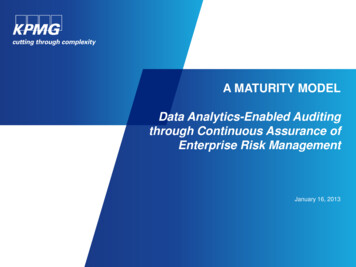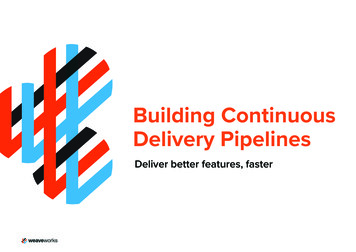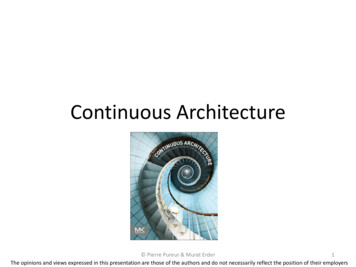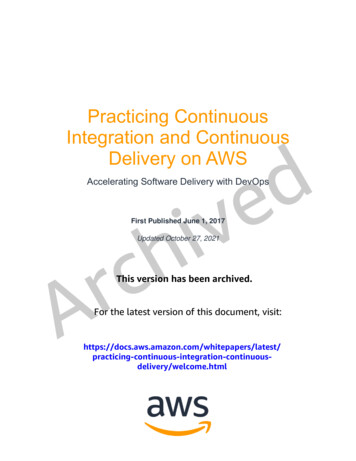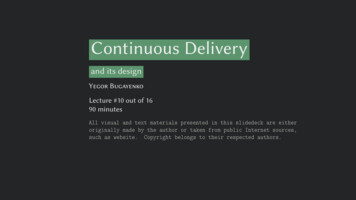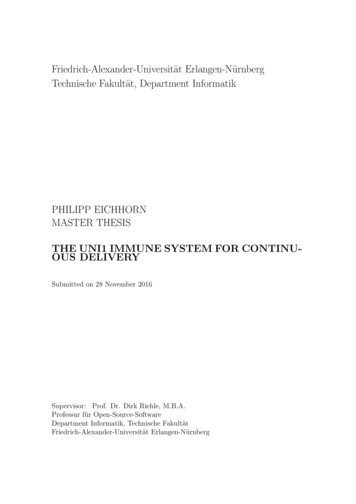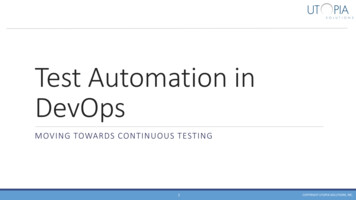
Transcription
Journal of Education and PracticeISSN 2222-1735 (Paper) ISSN 2222-288X (Online)Vol.7, No.31, 2016www.iiste.orgThe Practice of Continuous Assessment in Primary Schools: TheCase of Chagni, EthiopiaSintayehu Belay AbejehuDepartment of Pedagogy and Morality, College of Social Science and Humanities, Dire Dawa UniversityAbstractContinuous assessment is part and parcel of instructional process that has to be taken as a key tool in educationalquality assurance endeavor. Thus, this article examined the actual practice of continuous assessment in primaryschools of Chagni City Administration, Ethiopia. To address this purpose the study employed descriptive surveydesign. The data collected from randomly selected sample of 72 primary school teachers was analyzed by usingone-sample t-test. There is discrepancy between the perceived purpose of continuous assessment and its actualpractice. In conclusion, the practice of continuous assessment in primary schools lacks harmony and consistency.Developing harmonized continuous assessment policy or guideline is forwarded to the government asrecommendation.Keywords: continuous assessment, practice, primary school, assessment for learning1. IntroductionNowadays, in the world of education, continuous assessment has been recognized as an integral part of everydayclassroom instruction and a key tool to ensure quality learning. Accordingly, every educational institution, inEthiopia, irrespective of its level, has been using continuous assessment as a key to determine students’ learningachievement and identify their learning difficulties for special supports, to improve teacher’s pedagogicalpractices, and to improve quality of education in general. In line to this, Ethiopian Ministry of Education (MoE,1994) pinpointed in New Education and Training Policy of Ethiopia that continuous assessment in academic andpractical subjects will be conducted to ascertain the formation of all round profile of students at all levels.Moreover, Ministry of Education (MoE, 2011:119) pointed out thatAn essential element of the move to personalized learning is the use of assessment for learning(formative assessment) as well as assessment of learning (summative assessment). Teachers areencouraged to use a range of assessment techniques that are appropriate to the learning activities ofthe students in order to fulfill the primary aim of assessment which is to support learning.Undoubtedly, effective practice of CA yields great contribution in the campaign to assure quality ofeducation. In this regard, CA has abundant purposes to serve including improvement of the teaching andlearning process and motivating students to work harder, and thus, its success should be measured in termsopportunities it provide for educational quality enhancement. In light of this, National Science TeachersAssociation (NSTA, 2003) contends that an assessment operates to improve student learning, not solely tomeasure it, when it is used to move the student from his or her current understanding to where the student wouldlike to be. Similarly, UNICEF(2000) cited in the General Education Quality Assurance and ExaminationsAgency(GEQAEA,2008) pointed out that frequent assessment and feedback is the one of the variables thatcontribute to better student learning outcomes and quality of education. Similarly, research findings by Birhanu(2013) and Desalegn (2014) documented that CA is a good practice for improving students’ performance,monitoring students’ learning progress, improving methods of teaching, motivating and grading students’achievement. However, the benefits of assessment can be enjoyed only if it is based on learning objectives(ENQA, 2007; Earl, 2006 cited in Yared, 2012). Thus, to ensure effective teaching of subject matter and to helpstudents acquire the required knowledge, skill and attitude every teacher should maintain good practicecontinuous assessment.As to Kapambwe (2010), the objectives of the CA are twofold: firstly, to promote the use of formativeassessment so as to improve the quality of learning and teaching and secondly, to establish a regular systemof managing implementation of the programme or curricula. Similarly, Arega(2014) has documented thatthere is considerable evidence that continuous assessment is a powerful instrument for enhancing the attainmentof learning outcomes to ensure quality education and academic excellence in the education institutions.In the broadest sense, as learning is the main reason schools exist, every school needs to systematize theway learning is continuously assessed within the school. While discussing about continuous assessment, it isscholarly recommended to view it in light of assessment of learning, assessment as learning and assessment forlearning. This entails that student learning should be continuously assessed and timely feedback should be givenso that it is possible to capitalize on the outcome of the assessment and take possible action (re-teaching and reassessment) for better learning (HESC, 2012).Despite acknowledgement of the importance of CA by abundant educators, its practice is evidencedwith tremendous pitfalls. In connection to this, Esere and Idowu (2009) found out that CA has not made the24
Journal of Education and PracticeISSN 2222-1735 (Paper) ISSN 2222-288X (Online)Vol.7, No.31, 2016www.iiste.orgexpected contribution to students’ school performance due to inherent problems in its operation. Similarly,Diamond (1998) described that the fundamental problem in assessment practices to be the mismatch between thelearning targets established and the methods and criteria teachers use to assess their students. Moreover, Fisseha(2010) found that the current state of assessment, particularly formative assessment (also named as assessmentfor learning) is not in line with best practices to enhance student learning and realize curriculum intentions.Tremendous literatures and scientific evidences have revealed that many educators and learners viewCA as merely assessment of learning (summative), barring assessment for learning (formative) away. Forinstance, Obioma(2010) cited in Awofala and Babajide(2013) has investigated that many teachers misappliedthe CA instruments leading to more continuous testing instead of continuous assessment. Aytaged (2010) furtherasserted that judgmental role (summative) of continuous assessment is more practiced than the development role(formative) of the assessment. Similarly, some other studies also pinpointed the following findings viz.,teachers practice continuous assessment as continuous tests (Abiy, 2013), practice of the CA activities to assessstudents’ written work is not sufficient enough to improve the learning and teaching of a writing course (Yiheyisand Getachew, 2014) and judgmental role of continuous assessment is more practiced than the development roleof the assessment (Aytaged, 2013). Moreover, as documented by different researchers, some other problemsfound were that the entire practice of CA is surrounded by laxity (Birhanu, 2013), the assessment methods thatinstructors use are not effective in promoting good learning(Black & William, 2004 cited in Fisseha, 2010),teachers experienced difficulties in implementation of formative assessment (Israel, 2005 cited in Mpapalika,2013), teachers are complaining that CA increases the workload for teachers (Mpapalika, 2013), etc.To this end, the aforementioned findings have clearly revealed the existing deficiencies in the practiceof continuous assessment. As to the researcher’s experience and informal observation, Chagni CityAdministration primary schools seem to face certain problems in the practice of continuous assessment. Thus, asthere is no previous study that addressed this problem in the area, this article has examined the prevailingpractices of continuous assessment in the primary schools of Chagni City Administration, Ethiopia.2. Theoretical Framework2.1 What is Continuous Assessment (CA)?Different authors have defined continuous assessment differently based on their point of emphasis. Accordingly,Asabe (2007 cited in Abiy, 2013) defines CA as a classroom process that is integrated with instruction. Similarly,Falayalo (1986) and Juliet (2007), viewing it as an integral part of instruction, considers it as a mechanismwhereby the final grading of learners on the cognitive, affective, and psychomotor domains of learning ismade(cited in Abiy, 2013). Nitko (2004), on the other hand, described it as an information gathering tool thathelps teachers select content and method of instruction.According to Nitko (2004),Continuous Assessment is an ongoing process of gathering and interpreting information aboutstudent learning that is used in making decisions about what to teach and how well students havelearned (p.4).Another definition by Airasian(1991) describes CA as an assessment approach which should depict the full rangeof sources and methods teachers use to gather, interpret and synthesize information about learners.2.2 Contemporary Thoughts of Continuous Assessment: Assessment for Learning (AfL),Assessment of Learning (AoL) and Assessment as Learning (AaL)2.2.1 Assessment for Learning (AfL)Now a day, emphasis of curriculum assessment shifts from summative (assessment of learning) to formativeassessment (assessment for learning) to meet the dynamic needs of learners. Thus, in assessment for learning,teachers use assessment as an investigating tool to find out as much as they can about what their students knowand can do, and what confusions, preconceptions, or gaps they might have. Therefore, investigation resultsprovide the basis for determining what teachers need to do next to move student learning forward. In this regard,Okas(n.d.:4) contend that: assessment for Learning shifts the emphasis from summative to formative assessment, frommaking judgments to creating descriptions that can be used in the service of the next stage oflearning. [Teachers] craft assessment tasks that open a window on what students know and cando already and use the insights that come from the process to design the next steps inobservation, worksheets, questioning in class, student-teacher conferences or whatevermechanism is likely to give them information that will be useful for their planning and teaching.Marking is not designed to make comparative judgments among the students but to highlighteach students’ strengths and weaknesses and provide them with feedback that will further theirlearning.In reality, it is through classroom assessment that attitudes, skills, knowledge and thinking are fostered, nurtured25
Journal of Education and PracticeISSN 2222-1735 (Paper) ISSN 2222-288X (Online)Vol.7, No.31, 2016www.iiste.organd accelerated or stifled (Hynes, 1991 cited in Okas, n.d.).2.2.2 Assessment of Learning (AoL)Assessment of Learning is the predominant kind of CA in schools. According to Okas (n.d.), the purpose ofAoL is summative, intended to certify learning and report to parents and students about students’ progress inschool, usually by signaling students’ relative position compared to other students. AoL in classrooms istypically done at the end of something (eg, a unit, course, a grade, a program) and takes the form of tests orexams that include questions drawn from the material studied during that time. Okas also claimed that AoL is akind of assessment that still dominates most classroom assessment activities with teachers firmly in charge ofboth creating and marking the test. Thus, a strong emphasis is placed on comparing students, and feedback tostudents comes in the form of marks or grades with little direction or advice for improvement.2.2.3 Assessment as Learning (AaL)AaL emphasizes the role of the student, not only as a contributor to the assessment and learning process, but alsoas the critical connector between them. Students, as active, engaged, and critical assessors, can make sense ofinformation, relate it to prior knowledge, and master the skills involved. It occurs when students personallymonitor what they are learning and use the feedback from this monitoring to make adjustments, adaptations, andeven major changes in what they understand (Okas, n.d.). AaL is an approach where students are their own bestassessors.3. MethodFor this study purpose descriptive survey method was employed. A sample of 72 teachers was selected from thetotal population of 191 primary school teachers through simple random sampling technique, specifically lotterysystem. Questionnaire was used as data collection instrument. In relation to questionnaire as data collectionmethod, McMillan and Schumacher (2006:252) contend that “for many good reasons the questionnaire is themost widely used technique [and] is relatively economical, has the same questions for all subjects, can ensureanonymity and contains questions written for specific purposes.”Primarily the items were developed in English Language and translated to local language (Amharic) tomaintain common understanding among subjects. The questionnaire was pilot-tested by collecting data from 20teachers who were not included under the sample of the study. The data collected for pilot-study purposeCronbach alpha and its reliability estimate coefficient was α 0.62. The items were four-point Likert scaleranging from 1 to 4, where, for positively stated items, 4 stands for “Strongly Agree”, 3 for “Agree”, 2 for“Disagree” and 1 for “Strongly Disagree”. While scoring negatively stated items the numerical assignment toeach category was reversed. The option called “Neutral” was excluded to avoid judgmental response of theparticipants. One-sample t-Test was used to analyze the data.26
Journal of Education and PracticeISSN 2222-1735 (Paper) ISSN 2222-288X (Online)Vol.7, No.31, 2016www.iiste.org4. Results and DiscussionTable1: One-sample t-test result for the practice of CA in primary schoolsItemsMean SDSEMSig.(2tailed).040Calculatedvalue2.088t-I always assess students’ prior knowledge before starting 2.71.846 .100new lesson.I use CA only to give mark to students’ learning 3.17.712 .084 .0007.944performance.I always use CA during instruction to identify students’ 2.96.759 .089 .0005.126learning difficulties and interests.To monitor students’ learning progress I record their 2.99.741 .087 .0005.566performance in portfolio.After assessment I give prompt feedback to students 2.99.682 .080 .0006.052comprising their strengths and weaknesses.I give assessment feedback only by marking students’ 2.81.781 .092 .0013.321achievementI always share the objectives and tools of CA before actual 2.99.722 .085 .0005.715assessment process.I do not assess students’ learning outcomes of the affective 2.96.879 .104 .0004.424domain.I do not assess students’ learning outcomes of the 3.01.813 .096 .0005.360psychomotor domain.I continuously assess students’ learning progress by using 3.03.712 .084 .0006.294individual activities.I continuously assess students’ learning progress by using 3.08.622 .073 .0007.953group activities.I always support students with learning difficulties by 3.25.666 .078 .0009.554using CA as a tool.In my school all teachers use the same pre-defined CA 2.38.830 .098 .2051.278methods.I always assess students’ learning by using paper-and – 3.07.699 .082 .0006.916pencil tests.I give mark for attendance so as to decide whether a 2.74.839 .099 .0202.388student is promoted or not.I give mark for students’ exercise book so as to decide 2.61.848 .100 .2701.111whether a student is promoted or not.I use self-assessment as CA method.3.03.530 .062 .0008.450I use peer-assessment as CA method.2.81.725 .085 .0013.578I use observation as CA method.3.13.529 .062 .00010.024I use CA results to compensate students who might fail in 2.93.893 .105 .0004.090final exam.I always assess students’ learning progress in every lesson. 2.93.738 .087 .0004.951I always assess students’ learning once a week.2.88.821 .097 .0003.875I always assess students’ learning only once every two 3.19.664 .078 .0008.878week.I always assess students’ learning once in a month3.26.839 .099 0007.725As depicted in the table above, some of the primary school teachers always assessed students’ priorknowledge before starting the next lesson (item1). This result found statistically significant at p 0.05(t 2.088 &mean 2.71). In light of this result, Taylor (1999) contends that the purpose of CA is initial identification orscreening of students’ learning performance.According to Ministry of Education(MoE, 2006), beyond purpose of grading or marking students’performance, continuous assessment should serve the purpose of monitoring learning progress of students,providing students with constructive feedback, identifying learning difficulties and examining effectiveness ofteaching methodology. However, this study result revealed that primary school teachers used continuousassessment only to grade or mark students’ learning performance (see item 2). This result is statisticallysignificant at p 0.001(t 7.944 & mean 3.17). To the contrary, some other teachers have reported that theyalways used CA so as to identify students’ learning difficulties and interests. This result found statisticallysignificant at p 0.001(t 7.944 & mean 2.96, see item 3). Thus, based these results, it seems possible to infer27
Journal of Education and PracticeISSN 2222-1735 (Paper) ISSN 2222-288X (Online)Vol.7, No.31, 2016www.iiste.orgthat the primary school teachers have been practicing CA in different manner for different purposes.As portrayed in the above table, primary school teachers have asserted that they recorded students’performance in portfolio so as to monitor their learning progress(p 0.001, t 5.566 and mean 2.99, see item 4).Although some of the participants have reported that they give prompt feedback to students comprising theirstrengths and weaknesses (t 6.052, mean 2.99 & p 0.001, see item5) the result from some others, on the otherhand, revealed that primary school teachers provided assessment feedback only by marking studentsachievement(t 3.321, mean 2.81 & p 0.001, see item 6). These results foreshadow that feedback deliverysystem used by primary school teachers seem lack consistency. Consistent to this finding, Tefera (2014) foundout that teachers were not giving sufficient feedback to students in teaching learning process.Though some findings revealed that the primary school teachers always shared the objectives and toolsof CA (t 5.715, mean 2.99 & p 0.001, see item7) they did not assess students’ learning outcomes of affectivedomain (t 4.424, mean 2.96, p 0.001, see item 8) and psychomotor domain (t 5.360, mean 3.01, p 0.001, seeitem9). These results seem foreshadow that the primary school teachers fail to consider the three learning domainobjectives of the courses. However, CA has the role of analyzing the level of knowledge, skill and ability oflearners in different subjects (Institute of Curriculum Development and Research (ICDR), 1999)As showed in the above table, the study results revealed that primary school teachers used individualactivities (item10) and group activities (item11) to continuously assess students’ learning progress. These resultswere found statistically significant at p 0.001(t 6.294 & 7.953, mean 3.03 & 3.08 respectively). Similarly,results also revealed that primary school teachers have used self-assessment (item17), peer-assessment (item18)and observation method (item 19) as CA tool to assess students’ learning performance and progress. Thesefindings found to be statistically significant at p 0.001(t 8.450, 3.578 & 10.024 and mean 3.03, 2.81, & 3.13respectively). Based on these findings, one perhaps can infer that primary school teachers seem used varietymethods of continuous assessment. In connection to this, Meherns and Lehman (1991) argue that the classroomCA must not be restricted to conventional paper-and –pencil achievement tests rather they must use variety ofassessment techniques like rating scales, checklists, observation and so forth.Moreover, Ethiopian Ministry of Education (MoE, 2006:144) asserted that “ a teacher is expected to usecontinuous assessment to monitor the progress of students, understand the principles of continuous assessmentand [identify] the varieties of techniques that can be used.”The participant primary school teachers also affirmed they always support students by identifying theirlearning difficulties through continuous assessment. This result found statistically significant at p 0.001(t 9.554,mean 3.25, see item12). However, teachers’ did not use the same pre-defined CA methods (t -1.278, mean 2.38, p 0.2, see item13). Thus, it is possible to infer that there was disharmony among teachers in usingassessment tools though they supported students by identifying their learning difficulties through CA. However,Tefera (2014) found that most teachers did not include a variety of CA tools in their plan and did not use in theclassroom activities.As depicted in the table, primary school teachers always assess students’ learning outcome by usingpaper-and –pencil tests (see item 14). This result was statistically significant at p 0.001(t 6.916 & mean 3.07).Thus, this finding shows that, still, there are some teachers who use CA only for summative purpose (assessmentof learning). Therefore, the role of CA as assessment for learning (formative purpose) seems ignored by some ofprimary school teachers. Consistent to this finding, Obioma(2010) cited in Awofala and Babajide (2013)investigated that many teachers misapplied the CA instruments leading to more continuous testing instead ofcontinuous assessment. Aytaged (2010) further asserted that judgmental role of continuous assessment is morepracticed than the development role of the assessment.Research results showed that primary school teachers assign marks to classroom attendances to decideon the promotion of a student (see item15). This result found to be statistically significant at p 0.001(t 2.388,mean 2.74). On the other hand, even though the observed mean (2.61) seem numerically greater than theexpected mean (2.5), the results assured that the primary school teachers did not assign a mark to students’exercise books (t 1.111, mean 2.61, p 0.2, see item 16). On the other hand, findings of the study also revealedthat teachers have used continuous assessment to compensate students who might fail in final exam (see item 20).This result found statistically significant at p 0.001(t 4.090 & mean 2.93). Based on this result one can inferthat the practice of continuous assessment is not yet free from doubts. In connection to this finding, tremendousresearchers have documented the problems in the practice of CA. Accordingly, some of the problems foundwere that the entire practice of CA is surrounded by laxity (Birhanu, 2013), the assessment methods thatinstructors use are not effective in promoting good learning (Black & William, 2004 cited in Fisseha, 2010),teachers experienced difficulties in implementation of formative assessment(Israel, 2005 cited in Mpapalika,2013), teachers are complaining that CA increases the workload for teachers(Mpapalika, 2013)In this study the primary school teachers have reported varied frequency of assessment. As depicted inthe table above, some teachers assessed students’ learning outcome every lesson (t 4.953 & mean 2.93, seeitem 21) while some others assessed students’ learning outcome once in a week (t 3.875 & mean 2.88, see item28
Journal of Education and PracticeISSN 2222-1735 (Paper) ISSN 2222-288X (Online)Vol.7, No.31, 2016www.iiste.org22), once every two week (t 8.878 & mean 3.19, see item 23), and once in a month (t 7.725 & mean 3.26, seeitem 24). These results were found statistically significant at p 0.001. In contrast to these findings, Ministry ofEducation (2006) pinpointed that teachers are expected to regularly monitor, assess, and recs.ord the aptitude,abilities, needs and progresses of student. Similarly, Dawit et al. (2008) contend that in teaching-learning processit is indispensible or imperative to conduct periodic assessment of student learning vis-à-vis their attainment ofthe intended outcomes.5. ConclusionThe primary school teachers have used CA to identify students’ prior learning background at inception level.Assessment feedback system was not consistent and varies from teacher to teacher. Accordingly, some of theteachers have provided constructive assessment feedback comprising strengths and weaknesses of each studentwhile others have used row mark as a feedback. The purpose continuous assessment has served varies fromteacher to teacher. In this regard, some of primary school teachers have used CA to identify students’ learningdifficulties and learning interests(purpose assessment for learning) while others have used it to assign mark tostudents’ learning achievement( purpose of assessment of learning). There are some primary school teachers whostill use only paper-and-pencil tests as CA tool. These teachers seem considered continuous assessment ascontinuous testing. The primary school teachers have assessed objectives of cognitive domain, and totally left toassess the objectives of affective and psychomotor domain. Thus, there is discrepancy between the perceivedpurpose of continuous assessment and what the teachers have used for. To conclude, the practice of continuousassessment in primary schools lacks harmony and consistency. As recommendation, the government shoulddevelop harmonized continuous assessment policy or guideline if CA is to serve its purpose.ReferencesAbiy Yigzaw. (2013). High school English teachers' and Students’ perceptions, attitudes and actual practices ofcontinuous assessment. Academic Journals Vol. 8(16), pp. 1489-1498. Availableonline: http://www.academicjournals.org/ERRArega Mamaru.(2014). Classroom Assessment Manual for Primary and Secondary School Teachers. NEAEA,Addis Ababa.Airasian, P.W. (1991). Classroom Assessment. New York, McGraw-HillAwofala A.O. & Babajide V. (2013). Examining Attitude towards Continuous Assessment Practices amongNigerian Preservice STM Teachers. Journal of Education and Practice Vol.4(13) p37-49. Availableonline: www.iiste.orgAytaged Sisay. ( 2013). A comparative study on the practice of continuous assessment between Addis Ababaand Unity Universities. Global Journal of Comparative Education Vol. 1 (1), pp. 50-58. Availableonline: http://globalscienceresearchjournals.org/full- articles/Birhanu Moges. (2013). Continuous Assessment Issues and Practices in Secondary Scools of Oromia RegionalState, Ethiopia: THE “BIG PICTURE” of Assessment Mechanism. Available online:http://www.palgojournals.orgDawit Asrat, Dawit Mekonnen and Yalew Endawoke. (2008). Amhara Region Learning Assessment of GradeEight Students. Amhara Education Bureau, Bahir Dar, Ethiopia.Desalegn Chalchisa.(2014). Practices of Assessing Graduate Students’ Learning Outcomes in Selected EthiopianHigher Education Institutions. Journal of International Cooperation in Education, Vol.16(2) pp.157 180.Diamond, R. M. (1998). Designing and Assessing Courses and Curricula: A Practical Guide. Sanfrancisco:Jossey-Base Inc.Esere. M and Idowu.A. (2009). Continuous Assessment Practices in Nigerian Schools. University of Ilorin,Nigeria: Retrieved from: http://www.iaea.info/documents/paper 2fb222d82.pdfFisseha Mikre .(2010). Review Article: The Roles of Assessment in Curriculum Practice and Enhancement ofLearning. Ethiopian Journal of Education & Science Vol. 5(2),pp. 101-114.GEQAEA. (2008). Ethiopian Third National Learning Assessment of Grade 8 Students. Ministry of Education,Addis Ababa, Ethiopia.HESC. (2012). A Guideline for Modularization to Ethiopian Higher Education Institutions. Organized by HigherEducation Strategy Center (HESC), Ministry of Education, Ethiopia.ICDR .(1994). Teacher Education Handbook. Addis Ababa , Ethiopia. FinFinne Printing and Publishing Press.Kapambwe W.(2010). The implementation of school based continuous assessment (CA) in Zambia. EducationalResearch and Reviews Vol. 5(3), pp. 099-107. Available online: http://www.academicjournals.org/ERRMeherns, W. and Lehman, J. (1991). Measurement and Evaluation in Education and Psychology. 4th ed.,Wadsworth, Thomson Learning.McMillan, J. and Schuncher, S. (2006). Research in Education: Evidence-based Inquiry. 6th ed. Boston: Pearson.29
Journal of Education and PracticeISSN 2222-1735 (Paper) ISSN 2222-288X (Online)Vol.7, No.31, 2016www.iiste.orgMoE. (1994). Education and Training Policy. Federal Democratic Republic of Ethiopia, Addis Ababa. ST.GEORGE PRINTING PRESSMoE. (2006). Decentralized Management of Education in Ethiopia. A Reference Manual. Addis Ababa, Ethiopia,Ged Printing and Packaging Plant.MoE. (M2011).Handbook: Higher Diploma Programme for Teacher Educators. Addis Ababa,Ethiopia(Unpublished material).Mpapalika K.(2013). Tanzania science teachers’ practices and challenges in continuous assessment. Retrievedfrom: http://wiredspace.wits.ac.za/bitstream/ handle/National Science Teachers Association .(NSTA, 2003). Learning through Assessment: Assessment for Learningin the Science Classroom. Arlington, Virginia: NSTA Press.Nitko , A.J.(2004). Educational Assessment of Students. 4th ed. Ohio: Merrill Prentice Hall.Okas.(n.d.). Assessment of Learning, for Learning, and as Learning. Retrieved arl.pdfTaylor, R. (1999). Assessment of Exceptional Students: Educational and Psychological Procedures. 6th ed.Tefera Gashaw. (2014). Teachers Perceptions and Practices of Continuous Assessment in Mathematics Class inDera woreda General Secondary and Preparatory Schools. Addis Ababa University, AddisAbaba,Ethiopia(Thesis).Yiheyis Seyoum and Getachew Seyoum. ( 2014). The Implementation of Continuous Assessment in WritingClasses the of Jimma College of Teachers Education. Ethiopian Journal of Education & Science, Vol.10(1),pp. 109-135.
one-sample t-test. There is discrepancy between the perceived purpose of continuous assessment and its actual practice. In conclusion, the practice of continuous assessment in primary schools lacks harmony and consistency. Developing harmonized continuous assessment policy or guideline is forwarded to the government as recommendation.



